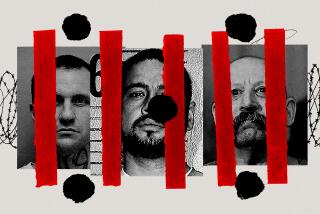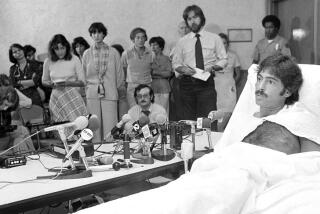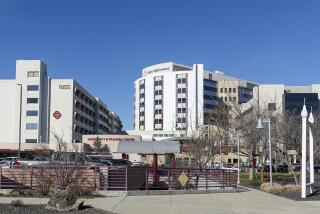Bill Wassmuth, 61; Ex-Priest Led Anti-Hate Group, Helped to Bankrupt Aryan Nations
Bill Wassmuth, a former priest who created one of the countryâs leading anti-hate organizations after members of the Aryan Nations firebombed his Idaho home, died Tuesday in Ellensburg, Wash. He was 61.
The cause of death was amyotrophic lateral sclerosis, the debilitating disorder commonly known as Lou Gehrigâs disease.
Wassmuth was a Roman Catholic priest active in human rights campaigns when his rectory-home and three other sites in Coeur dâAlene, were bombed by members of the white supremacy group in 1986. No one was injured, but four Aryan Nations members were convicted of the crimes.
Undaunted by the attack, Wassmuth helped found the Northwest Coalition Against Malicious Harassment, a six-state network of groups devoted to combating prejudice.
He played a central role in turning public opinion against the Aryan Nations, and was a key force behind the 2000 civil lawsuit that bankrupted the group and closed its compound in the north Idaho wilderness.
âIn my book, heâs a true hero,â said Morris Dees, the legendary civil rights lawyer who tried the case.
Wassmuth was raised on a farm in tiny Greencreek, Idaho, one of nine children in a devout Catholic family. In Greencreek, he once joked in an interview with the Seattle Times, âthe only people of color I ever saw ... were during the summer when the wheat farmers got tanned from riding their tractors.â
He learned about tolerance and the difference one person can make from his father, who managed a community skating rink. Some black children assigned to work at a nearby Job Corps facility had tried to skate at the rink, but the townspeople protested. The elder Wassmuth stood up to friends and neighbors and refused to discriminate.
Wassmuth entered seminary in eighth grade and was ordained in 1967, during the post-Vatican II era of reform in the Catholic Church. After a period serving in church posts around Idaho and working in religious education, he wound up in 1979 as parish priest at St. Pius X Church in Coeur dâAlene.
It was plain to his parishioners that he was no ordinary priest. He was a bearded white guy who wore his hair Afro-style and favored cowboy boots and a leather jacket over black robes and a clerical collar. He rode a motorcycle and water-skied with the townâs youths.
Although not especially tall or physically commanding, he was a charismatic speaker with a clear, resonant voice. His sermons attracted new worshipers, doubling the size of the parish to 800. Soon, a larger church was constructed, with mauve walls and pews built in a semicircle around the altar.
While Wassmuth was building his parish, Richard Butler, founder of the Aryan Nations, was strengthening his operation. Based at a 20-acre compound near Hayden Lake that he established in the 1970s, the former Southern California aerospace worker was recruiting ex-felons to help him foment his war of hatred. He attracted supporters who agreed with his views: that Jews were descended from Satan, that blacks were soulless descendants of âmud peopleâ and that white women who married outside their race should die.
By the mid-â80s, Butlerâs adherents were being arrested for an array of criminal activity--including bank robberies and counterfeiting--committed to support his racist agenda.
In 1984, Wassmuth became head of the Kootenai County Task Force on Human Relations. Under his leadership, the low-profile group became a visible force opposing the white supremacists. Butler began railing against the task force--and Wassmuth in particular--after the group rallied against an annual cross-burning at Butlerâs compound in July 1986.
Two months later, on Sept. 16, Wassmuth was talking on the telephone when an explosion rocked the ranch-style house that served as the St. Pius rectory and his home. He knew someone had just tried to kill him.
âI had never in my life had anyone be angry enough to raise a fist at me, much less attempt to kill me,â he told the Seattle Times earlier this year. âI said to God: âNow what?â â
âMany felt it was a time to hide,â said Marilyn Shuler, former director of the Idaho Human Rights Commission, who had met Wassmuth a few years earlier. âHe just said, âNo, no, no. We are going to continue to speak.â And he did that, even though he was targeted.â
Striking out against Wassmuth âwas the worst mistake [the Aryan Nations] ever made,â said Tony Stewart, a political science professor at North Idaho College in Coeur dâAlene and Wassmuthâs longtime friend. âNot only did it galvanize this community, but it made Bill prominent around the country. He became a priest for ... people all over the Northwest, promoting social justice.â
After the bombing, Wassmuth invited Dees to Coeur dâAlene to discuss the possibility of legal action against the Aryan Nations. Dees decided that he did not have enough evidence to link Butler to the crime, but he stayed in touch with Wassmuth over the next dozen years.
Wassmuth remained head of the county task force until 1988, when he made some dramatic personal changes. He left the priesthood and married a local artist, Mary Frances Dondelinger. She survives him, along with seven siblings.
He also began discussions with other activists about the need for a broader alliance to oppose organized bigotry. He moved to Seattle and became the first director of the Northwest Coalition Against Malicious Harassment. It later merged with another group, becoming the Northwest Coalition for Human Dignity, covering Oregon, Washington, Idaho, Montana, Colorado and Wyoming.
In 1998, a Native American woman named Victorian Keenan was terrorized and her son, Jason, was beaten by Aryan Nations security guards outside Butlerâs compound. They agreed to lend their names to a lawsuit intended to put Butler and his group out of business.
Dees came back to Idaho from his Southern Poverty Law Center in Montgomery, Ala. âIt was the memory of Bill Wassmuth and his fight over the years against Butler that made me want to come out there and finish the fight,â Dees told The Times this week. âI had tremendous admiration for him.â
The Keenansâ lawsuit contended that Butler and the Aryan Nations showed negligence in hiring and training security guards. In late 2000, a jury awarded the Keenans $6.3 million, which was believed to be the largest punitive damage award in Idaho history. Butlerâs compound was dismantled and is being converted into a peace park.
Wassmuth retired in 1999, planning to do some public speaking on tolerance and renovate an old Victorian house he and his wife had bought in Ellensburg. But the following year, he was diagnosed with Lou Gehrigâs disease, which atrophies the muscles and usually brings death within two to five years.
Although rapidly losing strength, he attended Butlerâs trial and savored the victory.
âHe was so pleased,â Shuler said, âthat justice was served.â
More to Read
Sign up for Essential California
The most important California stories and recommendations in your inbox every morning.
You may occasionally receive promotional content from the Los Angeles Times.











